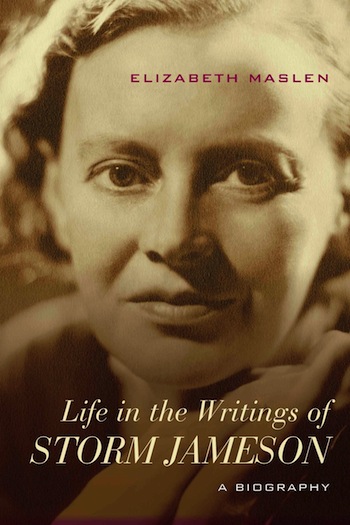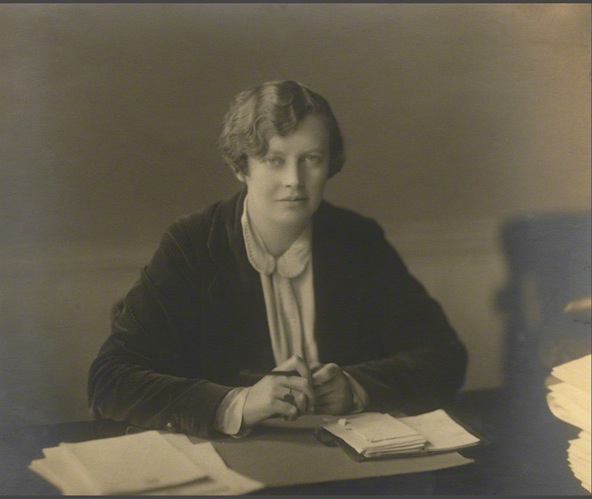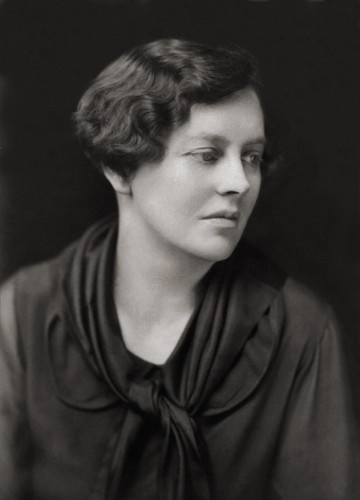Book Review: The Remarkable Life of Storm Jameson — Attention Tenderly Paid
After reading this scholarly and accessible biography, I am convinced that the story of Storm Jameson’s life is a must for anyone fascinated by the history of women writers in the 20th century.
Life in the Writings of Storm Jameson, A Biography by Elisabeth Maslen, Northwestern University Press, 556 pages, $40.
By Roberta Silman

I must confess that although I remember reading Storm Jameson in my 20s when I lived in London, she never became one of those authors I had to buy. Maybe I was too young, though more likely I was too influenced by “what was in” or by the early twentieth century writers who had been assigned in college and whose work I was reveling in without the pressures of papers and exams. Probably a more important factor was that, although Jameson produced an amazing number of novels and memoirs and biographies and articles and stories, and even plays and was still working full tilt while we were there, she has never received the attention she undoubtedly deserves. However, after reading this scholarly and accessible biography by Elizabeth Maslen, I am not only interested in reading and re-reading her work but am convinced that the story of her life is a must for anyone fascinated by the history of women writers in the 20th century.
Born in 1891 to a family of shipbuilders in Whitby on the northeastern coast of England, Margaret Jameson became a well-known figure in literary circles but was never in the thick of things as the Bloomsbury Group seemed to be, or even on the fringe of that prestigious and often arrogant group. Part of the problem was that Jameson was from an entirely different background, a scrappier, tougher one which was much more conventional and affected her life in profound ways. She made choices that might puzzle us now and were utterly baffling then: to marry when she was clearly too young and to become the breadwinner in two marriages that were far from ideal and, along the way, to go ahead with a pregnancy that saddled her with a child she was not sure she should have had.
Her remarkable life was long — she died in 1986 — filled with many “firsts,” a career that spanned both World Wars while she was still in her prime, and, despite her talent and amazing energy and ability to take risks, a life that produced only one biography –Jennifer Birkett’s in 2009, which is long on explication of the work and short on personal details. Now, though, we have this splendid portrait by Maslen, who is identified only as “a senior research fellow in the Institute of English Studies, School of Advanced Study, at the University of London,” an example of modesty unique on any book jacket.
Almost a decade younger than Virginia Woolf, nine years younger than Elizabeth Bowen, and closest in age to Rebecca West and Vera Brittain and Brittain’s good friend, Winifred Holtby, Margaret Jameson (Storm was a name taken for literary reasons) was well-known when she was alive because she seemed to be everywhere, active in all the right causes, at the very forefront of the literary scene when she helped found English PEN and was its first President for so long. Yet why has she somehow slipped into oblivion? One of the reasons may be she never seemed to have the confidence to blow her own horn, as West did. Another may be that she was too much of an activist — at a time when activism was in the business of saving lives, mostly during the period leading up to the Second World War and during it — to care about her legacy. Or that she didn’t come from a literary family and had no heirs (as Woolf and Brittain did) to ensure her literary future. Or that her works were incredibly varied — novels, memoirs, political tracts, and, literally, hundreds of articles. Or that she had money problems all her life, yet somehow could never live within her means.
Her need to be the “carer,” which evolved into an exhausting pattern of martyrdom and self-gratifcation that became fixed and increasingly troublesome as she matured, may have begun in her difficult childhood. Jameson’s mother, although ambitious for her eldest child, was a strong, volatile woman who did not spare the rod when Jameson was growing up; oddly those unforgettable thrashings created a relationship in which that demanding, rigid mother wielded a strange power over Margaret all her adult life. It began when Hannah Jameson found letters between Margaret and Charlie (Karl) Clarke when they were at Leeds revealing that they were lovers. Her parents, perfect products of Victorian England, insisted that they marry in January 1913.

Margaret Ethel (‘Storm’) Jameson. Photo: Walter Benington, for Elliott & Fry, circa, 1920s, courtesy of National Portrait Gallery, London.
By then Jameson had become the first woman to be awarded a first-class degree in English from Leeds University, and had already received a scholarship for her masters thesis from Leeds (another first) with an arrangement that she take advantage of the better research facilities at University College London. Living in a small flat in Shepherd’s Bush with Clarke proved dreary and challenging, and the marriage proved a disaster. An “elusive” character, Clarke never seemed to know how to make a living or even to contribute to their finances. To make matters worse, Jameson became pregnant in 1914 and had a son named Bill, who would prove a financial and emotional burden until he died in his late sixties, predeceasing her by a few years.
By the time she was saddled with her son, World War I was wreaking its terrible damage, and although Jameson somehow found the time and energy to publish two novels and sometimes care for her child or send him home to her mother and sister in Whitby for long periods, the end of the war didn’t bring much relief. Karl returned from the war unable to adjust to civilian routine, and Jameson’s need to earn a living led to habits that would last all her life. Writing books didn’t bring much money if you were unknown, so soon Jameson was cultivating friendships with the London “literati” as a means to keep her family afloat with income from articles, vignettes, short stories, whatever the editors wanted.
Among those early friends were Michael Sadleir, the Knopfs (who hired her to scout for them in England), Walter de la Mare, Margaret Sanger, and Guy Chapman, who had been gassed in the war, had divorced his first wife, and wanted to write. With Chapman, Jameson found a measure of serenity she had never before known. He became her second husband, and to all those who observed the marriage it seemed quite a strange match. But Jameson stayed in the relationship for the rest of her life, sometimes referring to the glories of intellectual or “imaginative” love. To balance the deficits in her marriage there were a number of very strong friendships, some of which lasted, some of which did not — with Vera Brittain and Czeslaw Milosz, Arthur Koestler, Herman Ould, Alfred Knopf, Jacquetta Hawkes, Jan Masaryk, and many others.

Margaret (‘Storm’) Jameson: here is a writer whose vision was deeply shaped by her enormous energy and capacity for engagement.
There was also political activity; Jameson had no patience with anti-Semitism in any form, was one of the first writers to become vocally anti-Hitler, and was a moving force in English PEN. Beginning in the early 1930s she also became very involved with many of the refugees fleeing Hitler’s Germany; she never seemed to deny any of them what they needed. This surely affected her work, yet Maslen is very clear that here is a writer whose vision was deeply shaped by her enormous energy and capacity for engagement, and, indeed, it may be that her life fed the work in unique ways. Moreover, this biography is a veritable treasure trove of literary comings and goings in Britain in the first two-thirds of the 20th century.
But its anchor is this dynamic, at times hectically busy woman whose health was often affected by her various activities and who now and again had to retreat — mostly to the homes of friends — to regain her strength. A woman who had an unshakeable sense of responsibility towards her family, even if she didn’t truly love all of them. A woman whose adored youngest sister Dorothy was killed in the London Blitz in the Second War and who never entirely recovered from that blow. A woman who thought she had a clear vision of why she wrote and what she was going to write about. Like her one-time mentor, New Age editor Alfred Richard Orage, Jameson felt she “had a duty to engage with and reflect on the issues of its day.” Maslen notes that in an article as early as 1920
she was wary of any work where a writer struck her as more concerned with expression than with subject matter. The subtleties and complexities of human behavior and their social repercussions must in her view be paramount.
In an introduction to the book that grew out of her MA thesis, Jameson observes that
… it is a demand that art should present life as worth living, should glorify it for us, give us inspiration, strength and faith in the power of the human spirit. For this reason the cry of art for art’s sake is an unmeaning phrase.
In a review of Woolf’s The Waves in 1931, Jameson argues:
She is like a woman who has turned her back on life and watches it passing in a mirror, so that nothing shall shake the steadiness of her glance, none of those distractions, those sudden blindings, that come from touching what one sees.
Five years later, paraphrasing from a lecture Jameson gave in Leeds, Maslen writes, “The novelist must be a ‘receiving station’ for the voices of society, rather than clinging to the dead and being deaf and blind to the living; everything depends on the novelist ‘being sensitive enough to detect the past and the future existing in the present.” Then the biographer includes this direct quotation from that lecture:
We need words that are things. And new and unexpected combinations of words to bring out the meaning — as sharply as it is brought out in a documentary film by choice of significant detail and the angle from which the picture is made.
Thus we see Jameson struggling — sometimes contradicting herself — to distill what it is that made certain writers — like D.H. Lawrence, Stendhal, Camus — so important to her (three of my favorites, too) and why others left her cold. And how these ideas might inform her own writing. She was a writer for whom, as Mavis Gallant has said, “art was life or death.” And that is exactly what makes her so likable and interesting, even as she grew older, more aware of her flaws and her position in the history of English literature. Here is her refusal to whitewash her situation when she commented in a forum on British Books Around the World, on
the half-pained, half-ironical anxiety of an aging writer sitting ignored in a room full of chattering, self-absorbed young writers who, he more than suspects, if they have heard of his books at all, have not read them and never will.
But what makes this book so necessary is that Maslen, through all the sometimes exhausting detail, gives us a portrait of someone so alive, so attuned to the world around her, yet possessed of that intangible spark of life that is indescribable — we simply know when we see it. Here is Margaret Jameson in her prime, at her best, describing what she wanted to do in her last surge of writing after the Second World War, insisting that the writer must
listen as carefully as he can to the warnings of the present and the future, and give the most truthful account of them … Only the artist … can tell us how, under what conditions, man can survive as a fully human being. By this I mean a being who is not only human, not only an existential animal, but a creature who is partly divine, endowed with a divine curiosity and a great, though tragic, destiny.
As my last review in this often tragic year, when writers are faced with similar challenges to those facing Jameson after she had lived through the Second World War, I heartily recommend Life in the Writings of Storm Jameson. Reading it would be a good way to begin 2015 because this biography would be a standout in any year: it is written with care, honesty, and an uncommon tenderness.
Roberta Silman is the author of a story collection, Blood Relations, now available as an ebook, three novels, Boundaries, The Dream Dredger, and Beginning the World Again, and a children’s book, Somebody Else’s Child. A recipient of Guggenheim and National Endowment for the Arts Fellowships, she has published reviews in The New York Times and The Boston Globe, and writes regularly for Arts Fuse. She can be reached at rsilman@verizon.net.
Tagged: 20th century, Elisabeth Maslen, English, Northwestern University Press, Storm Jameson
